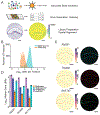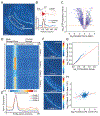Highly sensitive spatial transcriptomics at near-cellular resolution with Slide-seqV2
- PMID: 33288904
- PMCID: PMC8606189
- DOI: 10.1038/s41587-020-0739-1
Highly sensitive spatial transcriptomics at near-cellular resolution with Slide-seqV2
Abstract
Measurement of the location of molecules in tissues is essential for understanding tissue formation and function. Previously, we developed Slide-seq, a technology that enables transcriptome-wide detection of RNAs with a spatial resolution of 10 μm. Here we report Slide-seqV2, which combines improvements in library generation, bead synthesis and array indexing to reach an RNA capture efficiency ~50% that of single-cell RNA-seq data (~10-fold greater than Slide-seq), approaching the detection efficiency of droplet-based single-cell RNA-seq techniques. First, we leverage the detection efficiency of Slide-seqV2 to identify dendritically localized mRNAs in neurons of the mouse hippocampus. Second, we integrate the spatial information of Slide-seqV2 data with single-cell trajectory analysis tools to characterize the spatiotemporal development of the mouse neocortex, identifying underlying genetic programs that were poorly sampled with Slide-seq. The combination of near-cellular resolution and high transcript detection efficiency makes Slide-seqV2 useful across many experimental contexts.
Conflict of interest statement
Competing Interests:
R.R.S., F.C., and E.Z.M. are listed as inventors on a pending patent application related to the development of Slide-seq.
Figures



References
Main Text References:
-
- Codeluppi S et al. Spatial organization of the somatosensory cortex revealed by osmFISH. Nat. Methods 15, 932–935 (2018). - PubMed
Online Methods References:
-
- Storey JD A Direct Approach to False Discovery Rates. J. R. Stat. Soc. Series B Stat. Methodol 64, 479–498 (2002).
-
- org.Mm.eg.db. Bioconductor http://bioconductor.org/packages/release/data/annotation/html/org.Mm.eg.....
Publication types
MeSH terms
Substances
Grants and funding
LinkOut - more resources
Full Text Sources
Other Literature Sources

